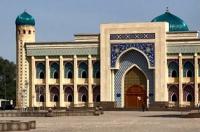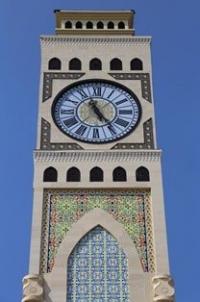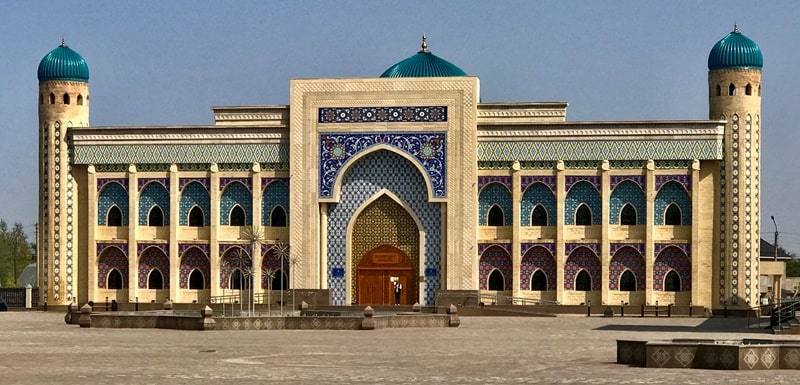You are here
Museum of Local Lore Taraz.


Office Attractions in Taraz.
“The history of the ancestors is always curious for someone who deserves to have a Fatherland”
N.M. Karamzin.
Museums tours in Taraz.
The regional museum of local lore in Taraz in the summer of 2020 moved to a new building at the historical and local history complex "Shahristan" in the city center. Regional Museum of Local Lore. It is a two-storey building with four exhibition halls, a conference hall, utility and technical premises in an oriental style.
The walls are finished with Venetian plaster, the floor is granite. The high vaulted ceiling of the main entrance to the museum is decorated with glazed tiles in the oriental style. Narrow vaulted and lattice windows with figured mosaics are made of durable plastic.
The design of the columns and walls decorated with petroglyphs in one of the halls is made in an antique style - with cracks and abrasions. The museum will have four completely different halls. Everyday life, culture and history of the region will be covered here.
The exhibition pavilion, designed to display the achievements and advanced technologies of our time, includes a meeting room and conference hall, as well as technical and administrative premises. All premises are equipped with modern IT technologies.
The Gallery of Fine Arts is intended for the exhibition of paintings of different directions. There are also premises for master classes by artists”. The gallery of handicrafts masters is intended for the study and development of handicrafts.
The Zhambyl Regional Museum of History and Local Lore was opened in 1931, as evidenced by archival documents. The resolution adopted at the meeting of the Council of Auliye - Ata Museum of Local Lore on August 23, 1931 states: “The museum should be opened on August 25, as announced through the radio node of the Auliye-Ata town Council.
Open for visitors from 5 to 8 hours daily, and for excursions - by special arrangement. The entrance is free". The widest circles of the urban community took an active part in the creation and replenishment of the museum’s funds: the intelligentsia, factory workers, and schoolchildren.
Then the museum occupied a small building, consisting of 2 exhibition halls, an office and a watchman's room. The area of the museum is only 328.5 square meters. The most valuable exhibits of the museum were originally archaeological collections.
The scientific description and dating of archeological objects was carried out then by a young scientist M.E. Masson. The most active part in the organization and work of the museum was taken by the famous Kazakhstan archaeologist, candidate of historical sciences G.I. Patsevich In the late 40s, the museum acquired a new status.
This is no longer a city, but a regional museum, designed to reflect the history and culture of an entire region. The first scientific plan for the reorganization of the museum was drawn up by the scientific staff of the museum, now a prominent scientist, doctor of art history L.I. Rempel.
In the 1950s and 1960s, the museum took an active part in the study of the lower reaches of the Talas River, conducted by the Academy of Sciences of the Kazakh SSR. A number of unique ancient settlements were revealed: Tekturmas, Kurgun-Bai-Tyube, Yany-Kurgan and others.
As a result of research, the museum was replenished with samples of irrigation and non-irrigated ceramics, bronze objects, fragments of glass products, etc. The employees of the regional museum took control of all the excavation work carried out on the territory of the Taraz settlement and delivered everything that was identified and of scientific interest to the regional museum.
An archaeological expedition led by a museum employee A.P. Popov, excavations were made. ancient Taraz bath lX – Xll centuries. In the mid-1970s, the Zhambyl Regional Museum was included in the All-Union tourist route, and since 1977, groups of foreign tourists began to visit it. In 1978, the regional museum was allocated a 3-storey building in the very center of the town.
In 13 exhibition halls, the main milestones of history were reflected in chronological sequence - from the first paleontological finds to the present day. The history of our region at different times was studied by such famous scientists as Bartold V.V., Senigova T.N., Bernshtam A.N., Akishev K.A., Alpysbaev H.A., Baipakov K.M., local history experts - Baybosynov K.P., Popov A.P., Patsevich G.I., Ivanov I.I. and etc.
As a result of archaeological and scientific gathering expeditions, the museum’s fund increased. Currently, there are about 35,000 storage units registered in the regional museum. In 2002, by the 2000th anniversary of the town of Taraz, the museum opened 3 more new pavilions:
“Museum of Ancient Turkic Writing and Ancient Turkic Stone Statues”, Museum of the History of the City “Taraz - 2000”, Art Museum of L.V. Brummera. The total exhibition area of the modern museum complex is almost 2000 square meters. meters.
The nature department opens the museum exposition. The visitors are interested in paleontological collections: petrified remains of marine animals, the remains of bones of large animals, petrified trees, etc. A large collection of representatives of the flora and fauna of the region is shown.
The archeology section acquaints visitors with the beginning of a person’s labor activity. Here is a large collection of stone tools found in the Karatau mountains by the scientific expedition of Professor Alpysbaev H.A. The fossil remains of man, a bronze sickle, jewelry made of bronze date from a later period - the era of bronze - the second millennium BC.
Of particular interest are the finds of the Saka period: figures from the altars, arrowheads and spears, the bronze helmet of the Saka warrior. By the way, in the entire CIS, only three such helmets were found, one of which was found in the Zhambyl region.
The exposition of the museum of the Taraz period presents a large collection of products made of non-irrigated and irrigated ceramics: various vessels of large and small shapes, kitchen utensils, water pipes, lamps, spherical cones, dastarkhans, burial vessels - ossuaries, bronze products: lamps, incense burners for incense, coasters for incense burners and lamps, vessels, etc.
In the year of celebrating the 2000th anniversary of Taraz, a large collection of expanses from the Taraz period visited France, Paris, at UNESCO headquarters. The ethnography hall is one of the richest expositions of the museum.
Everything that is presented in it was made by the hands of Kazakh folk craftsmen. The pride of the museum is the “Museum of Ancient Turkic Writing and Stone Statues”. The museum’s construction is unusual - a semicircular structure, symbolizing both the mound on which a stone statue was placed, and the yurt - the ancient home of the nomads, and the hemisphere - the connection of times and generations.
In this museum, stone sculptures appear as close as possible to their natural location, come to life, telling about the history of ancient tribes and peoples. The third new museum of the museum complex is the art museum.
It is dedicated to the work of a unique artist L.V. Brummer, repressed and exiled at the beginning of the war to Kazakhstan. The last 15 years of his life, from 1955 to 1971, he lived in Dzhambul (Taraz) and bequeathed his entire collection of paintings (more than 1000 paintings) to the town.
The main merit in creating this museum complex belongs to a creative group of artists - designers of the Zaman-Tu association, headed by the honored art worker of Kazakhstan Sh. Kozhakhanov, artists - the designer Sh. Kozakhanom, B. Kazangapov, B. Kucherbaev, S. Pozharsky, N. Alishariev and others.
Geographic coordinates of the local history museum in Taraz: N42 ° 54'01.68 "E71 ° 23'36.42"

Authority:
Museum advertising booklet.
Photos
Alexander Petrov.







